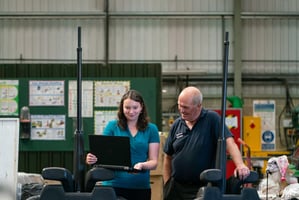“The dissolution of thoughts in eternal awareness or pure consciousness without objectification,...
Emerging Robotic Technology for Home Healthcare
The U.S. population is aging, and the availability and affordability of home healthcare is a national issue. According to estimates by the U.S. Census Bureau, 16% of the U.S. population was 65 and older in 2018, and the median age of citizens was 38.2 in 2018 (an increase of 1 year from 2010). At the present rate of population growth, seniors will outnumber people under 18 in this country by 2035 (readers who want to track the projected growth of both population cohorts can click here). The average life expectancy at birth for males in America is 76.1 years, and for females 81.1 years (2017 data). Males who reach 65 live, on average, 18.1 more years, and females who live to 65, live an average of 20.6 additional years.
With this aging, of course, come concerns about the availability and affordability of healthcare. As of 2018, about 1.4 million people lived in about 55,000 nursing homes or assisted living facilities in the U.S. Experts predict that number to double by 2030. The average cost of a private room in a nursing home in 2020 is $8,365.00 per month ($275.00/day), and of a semi-private room $7,441.00 per month ($245.00/day). Assisted living averages about half that, at $4,000.00 per month. Of course, rates in both types of facility increase for specialized memory care and additional services for some disabilities.
Home healthcare options cost out, on average, more than assisted living, but less than nursing homes. Traditional home health care aides who provide light housekeeping, medication reminders and companionship average $20.50 per hour ($164.00/day; $4,920.00/month). Skilled nursing care from trained and certified nurses or therapists who provide medication administration, wound and injury care, and various types of therapy care averages $220.00/day ($6,600.00/month).
As the Boomer generation ages, the U.S. finds itself on the cusp of dealing with an unprecedented number of people requiring home elder care. In fact, the home elder care market, which was $100 billion in 2016, will be $225 billion by 2024. The increase is being driven by the expanding elderly population (i.e.,) people 65 and older) that is projected to increase 147% during the period 2000 to 2050 and from an overwhelming preference to age in place. More seniors needing healthcare means an increase in demand for home healthcare workers that will require hundreds of thousands of new workers in the field over the next few years. Current shortages of these workers vary by state. Illinois, for example, is facing a 30% shortage versus demand.
Given the cost of senior healthcare, increasing demand for home care alternatives, the shortage of home health workers, and the susceptibility of those workers to accidents and injuries on the job, medical experts and scientists are looking at robotics to alleviate this health situation. People’s notions about robotics probably vary significantly. Simply stated, however, robotics is an integrating technology for devising processes that integrate mundane tasks. It is one of the fastest trending technologies in healthcare. One reason is that they can perform human tasks effectively and more efficiently. Robots are adaptable to particular environments, situations, and tasks. With artificial intelligence (the science of developing a system or software to emulate human cognition by enabling computers to learn and adapt through experience and patterns, rather than inference), robots are even capable of making decisions. The medical robotics industry will be a $6.5 billion industry in 2020. Robotic surgical applications show great promise, particularly for surgeries that require high levels of precision, including nanosurgery, and make procedures less invasive and allowing for a quicker patient recovery period. The other burgeoning area in medical robotics is home care.
One company offering robotic home healthcare solutions is Comfort Keepers of Reston, VA. Its multi-functioning robot companion known as “Rudy” can perform injections, wound care, ostomy care and more. Rudy the robot is about the height of 10-year-old and can help seniors in several other ways through simple voice commands. Rudy can illuminate dark areas, call for help, carry things, set reminders, assist patients who need to use the restroom, and call family members or loved ones. Nurses or family members can even take control of Rudy and drive it around a senior’s home using an app. At a cost of around $5,000.00, it is comparable to the cost of a human home health worker.
In addition, robots can reduce or eliminate accidents and injuries home health workers experience. On-the-job-hazards include sharp object injuries, harmful exposures to chemicals and drugs, back injuries, latex allergy, violence, and stress. Cases of nonfatal occupational injury and illness with healthcare workers are among the highest of any industry sector. All things considered, home care robots may be the right solution for many seniors.



